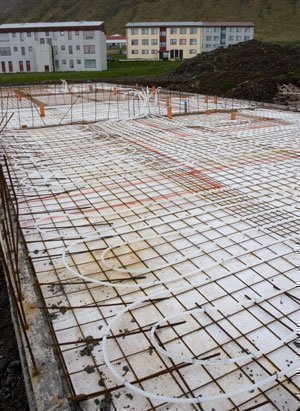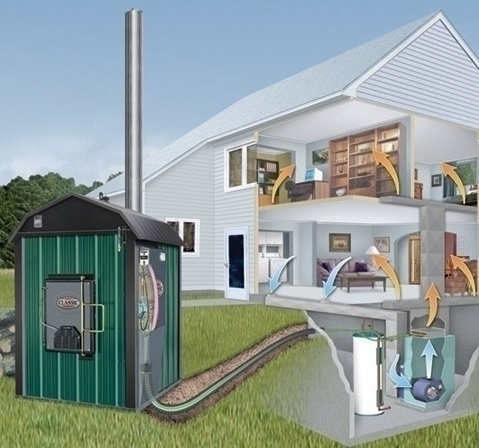Hydronic Heating
Hydronic heating is when tubing that contains hot liquid is run beneath a home’s floor. It uses radiant heating to heat a structure. This technique has become more popular with families who want to live in an energy efficient home and want lower heating bills. Hydronic heating also allows homeowners to control the temperature by room or heating zone, which allows infrequently used rooms to be kept at a lower temperature than those used more often.
How Does Hyrdonic Heating Work?
Hydronic heating systems circulate hot water or other liquid through the home through plastic piping or tubing. These tubes are normally installed in the concrete slab or floorboard and causes heat to radiate evenly across a room’s floor. Some hydronic heating system designs also use radiators or baseboard heating units depending on the home’s construction. The liquid that is pumped through the system is pre-heated and thermostats that interface with the manifold control center control its flow. Since the system uses a closed loop for the liquid flow, it heats more efficiently than other household heating systems.
How Hydronic Heating Makes a Room More Comfortable
By heating a room from the floor upwards, a more even and consistent heat is applied. This helps eliminate the excessive hot or cold spots forced air systems create. A hydronic system keeps tile floors warm in the winter. As a result of technological advances, homes no longer have to be built on a slab in order to support the installation of a hyrdronic heating system.
When installed during new construction, a hydronic heating system can be run underneath tile, wood, and carpeted floors. These systems also have an advantage over traditional heating blowers in that they do not lose heat by blowing hot air into an open room. As a result, hydronic radiant floor heating requires a lower thermostat setting to make a room or house feel comfortable.
When building a new home, ensure that the hydryonic system installation and flooring companies coordinate their installations in order to prevent future re-work. Some adjustments may have to be made to carpet thickness or type in order to prevent inadvertently installing an insulation layer that reduces the effectiveness of the hyrdonic heating system.
How Hydronic Heating Systems Work
Hydronic heating systems produce radiant heat through three steps:
Step 1 – The boiler system uses conduction in order to heat the water or cooling liquid contained in the hydronic heating system.
Step 2 – The hydronic heating system pumps the heated liquid throughout the home, which heats the floor and subsequently the room that the piping runs through.
Step 3 – The floor’s surface continuously heats the room, resulting in consistent temperatures.
Outdoor Hydronic Heater
An outdoor hydronic heater is a large water heating system that burns wood or other materials in a furnace to heat the water. Outdoor hydronic heaters are often the subject of debated criticism due to their low efficiency and high pollution levels. Outdoor hydronic heaters are rarely used in urban areas as they usually have more efficient heating systems such as water heaters and central air conditioning units. However, outdoor hydronic heaters are still found in rural areas and old foundations with outdated plumbing systems.
How does an Outdoor Hydronic Heater Work?
An outdoor hydronic heater is housed in a small, separate building such as a shed that is close to the building that it heats. A furnace or firebox that water surrounds is enclosed in the shed. A short smokestack is built into the furnace to allow smoke to exit. The water comes in from the main water supply, fills the chamber, and flows through an underground pipe to the house or building. A forced air furnace beneath the building then heats the water further and distributes it throughout the building’s plumbing network. The water then cycles back to the outdoor hydronic heater through a secondary underground pipe where the cycle repeats.
Criticism of Outdoor Hydronic Heaters
Outdoor hydronic heaters are generally criticized for producing large amounts of pollution. This is because they usually have relatively small smokestacks that are only six to ten feet tall and contain very large fires, causing large amounts of thick smoke to pour out into the surrounding area, which nearby residents breathe in. The smoke often takes several hours to disperse and only when all activity ceases. Likewise, users often burn green wood or garbage that contain chemicals or other toxic materials that are dangerous when inhaled or burned. In addition to its health risks, outdoor hydronic heaters are also inefficient as the initial installation fees and maintaining an ongoing supply of wood can be quite expensive. As a result, the EPA strongly discourages the use of outdoor hydronic heaters.
Where can an Outdoor Hydronic Heater be Found?
Because an outdoor hydronic heater was one of the first industrial heating systems, it is still found today in many rural areas that have not upgraded to more modern technology. However, due to their health risks, inefficiency, complicated installation, and cost, outdoor hydronic heaters are rarely sold anymore. This does not mean that outdoor hydronic heaters are not sold at all, however, as products, schematics, and useful information can be found at Central Boiler. Those interested in purchasing an outdoor hydronic heater should know that most states have regulations concerning the sale and use of outdoor hydronic heaters.


Comments - No Responses to “Hydronic Heating”
Sorry but comments are closed at this time.